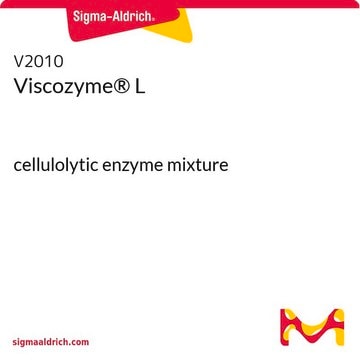This product is a partially purified, diafiltered, lyophilized cellulase complex containing exo- and endoglucanase activities. It is a native protein and does not include a His-tag.
Kluczowe dokumenty
C8546
Cellulase from Trichoderma reesei ATCC 26921
lyophilized powder, ≥1 unit/mg solid
Synonim(y):
1,4-(1,3:1,4)-β-D-Glucan 4-glucano-hydrolase
Wybierz wielkość
476,00 zł
Wybierz wielkość
About This Item
476,00 zł
Polecane produkty
Formularz
lyophilized powder
aktywność właściwa
≥1 unit/mg solid
charakterystyka ekologicznej alternatywy
Waste Prevention
Design for Energy Efficiency
Learn more about the Principles of Green Chemistry.
sustainability
Greener Alternative Product
rozpuszczalność
deionized water: soluble 5.0 mg/mL (Sterile; In the presence of 0.15% polyhexamethylene biguanide (PHMB).)
kategoria ekologicznej alternatywy
temp. przechowywania
2-8°C
Powiązane kategorie
Opis ogólny
Zastosowanie
Działania biochem./fizjol.
Definicja jednostki
Uwaga dotycząca przygotowania
Inne uwagi
substrat
Hasło ostrzegawcze
Danger
Zwroty wskazujące rodzaj zagrożenia
Zwroty wskazujące środki ostrożności
Klasyfikacja zagrożeń
Resp. Sens. 1
Kod klasy składowania
11 - Combustible Solids
Klasa zagrożenia wodnego (WGK)
WGK 1
Temperatura zapłonu (°F)
Not applicable
Temperatura zapłonu (°C)
Not applicable
Środki ochrony indywidualnej
dust mask type N95 (US), Eyeshields, Faceshields, Gloves
Wybierz jedną z najnowszych wersji:
Certyfikaty analizy (CoA)
Nie widzisz odpowiedniej wersji?
Jeśli potrzebujesz konkretnej wersji, możesz wyszukać konkretny certyfikat według numeru partii lub serii.
Masz już ten produkt?
Dokumenty związane z niedawno zakupionymi produktami zostały zamieszczone w Bibliotece dokumentów.
Klienci oglądali również te produkty
Protokoły
To standardize an enzymatic assay procedure of cellulase.
Ten protokół wykorzystuje test spektrofotometryczny do oceny aktywności celulazy. Celulaza z Aspergillus niger katalizuje hydrolizę wiązań endo-1,4-β-D-glikozydowych.
-
How has this enzyme been purified, Does it have a His-tag?
1 answer-
Helpful?
-
Active Filters
Nasz zespół naukowców ma doświadczenie we wszystkich obszarach badań, w tym w naukach przyrodniczych, materiałoznawstwie, syntezie chemicznej, chromatografii, analityce i wielu innych dziedzinach.
Skontaktuj się z zespołem ds. pomocy technicznej







